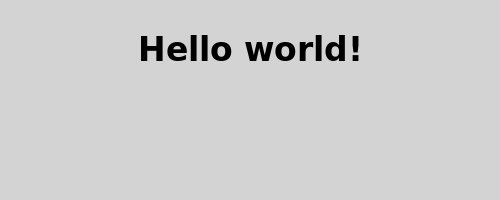
QML Tutorial QML Tutorial 2 - QML Components
This first program is a very simple "Hello world" example that introduces some basic QML concepts. The picture below is a screenshot of this program.

Here is the QML code for the application:
import QtQuick Rectangle { id: page width: 320; height: 480 color: "lightgray" Text { id: helloText text: "Hello world!" y: 30 anchors.horizontalCenter: page.horizontalCenter font.pointSize: 24; font.bold: true } }
First, we need to import the types that we need for this example. Most QML files will import the built-in QML types (like Rectangle, Image, ...) that come with Qt, using:
import QtQuick
Rectangle { id: page width: 320; height: 480 color: "lightgray"
We declare a root object of type Rectangle. It is one of the basic building blocks you can use to create an application in QML. We give it an id to be able to refer
to it later. In this case, we call it "page". We also set the width, height and color properties. The Rectangle type contains many other
properties (such as x and y), but these are left at their default values.
Text { id: helloText text: "Hello world!" y: 30 anchors.horizontalCenter: page.horizontalCenter font.pointSize: 24; font.bold: true }
We add a Text type as a child of the root Rectangle type that displays the text 'Hello world!'.
The y property is used to position the text vertically at 30 pixels from the top of its parent.
The anchors.horizontalCenter property refers to the horizontal center of an type. In this case, we specify that our text type should be horizontally centered in the page element (see Anchor-Based Layout).
The font.pointSize and font.bold properties are related to fonts and use the dot notation.
To view what you have created, run the qml tool (located in the bin directory) with your filename as the first argument. For example, to run the provided completed
Tutorial 1 example from the install location, you would type:
qml tutorials/helloworld/tutorial1.qml

As part of the free Business evaluation, we offer a free welcome call for companies, to talk about your requirements, and how the Felgo SDK & Services can help you. Just sign up and schedule your call.
Sign up now to start your free Business evaluation:

